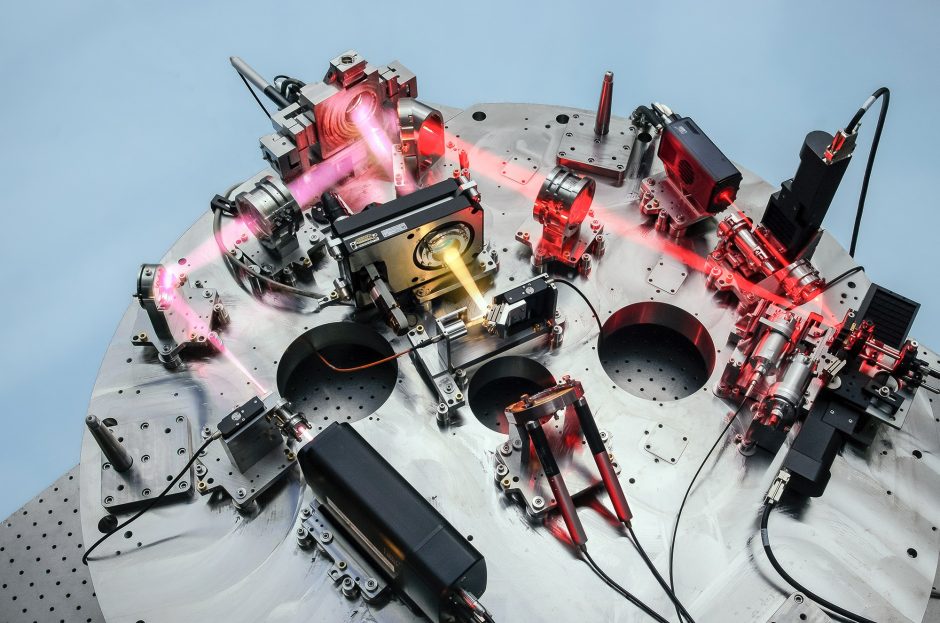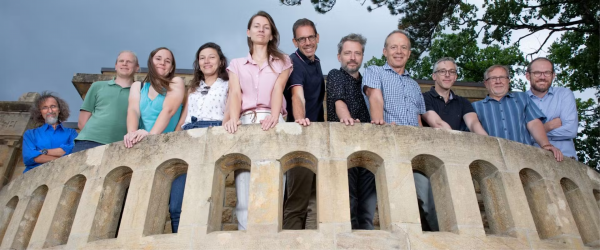Decoding the secrets of distant worlds: Swiss collaboration to help elevate exoplanet research to new heights

The quest to unravel the universe’s mysteries takes a leap forward as the Near Infra Red Planet Searcher (NIRPS) consortium, jointly managed by the University of Geneva’s (UNIGE) Department of Astronomy and the University of Montreal, has received a cutting-edge boost from CSEM’s laser frequency comb technology. This laser frequency comb, a precise and stable light source, has now joined the instrumentation lineup at the European Southern Observatory’s (ESO) La Silla Observatory in Chile. Its mission: to help the NIRPS consortium unlock distant planets’ hidden details, including the possibility of finding traces of extraterrestrial life. Through this collaborative endeavor, humanity’s grasp on the cosmos is poised to expand beyond imagination.

© CSEM – Representatives from CSEM, UNIGE, and ESO on the balcony of the Neuchâtel Observatory in Switzerland. CSEM developed the laser frequency comb that will work together with the NIRPS spectrograph to search for exoplanets.
Delving into the mysteries of distant words, the NIRPS consortium is on a mission to discover the details of telluric (Earth-like) exoplanets orbiting stars beyond our reach. These “cosmic nomads” have intrigued astronomers for nearly three decades. How can we gauge their weight, measure their temperatures, and decode their atmospheres? These are the questions that drive the NIRPS consortium. As a sophisticated and highly advanced spectrograph, NIRPS scrutinizes the light emitted from distant stars and detects tiny variations caused by the gravitational pull of the planets in their orbit.
Enhancing NIRPS with a laser frequency comb
In a seamless stride towards innovation, the NIRPS spectrograph now has a new partner: a laser frequency comb developed by CSEM, the Swiss technology innovation center. Commissioned by UNIGE, this device generates light with an exceptionally steady frequency spectrum, characterized by evenly spaced lines. It serves as an optical benchmark, aiding the measurement of a star’s radial velocity—a crucial metric for understanding the speed at which stars move towards or away from us. CSEM’s laser frequency comb, installed at ESO’s La Silla Observatory in Chile, will now meticulously calibrate the NIRPS spectrograph to unprecedented levels of accuracy and precision. As a result, NIRPS will gain a heightened ability to determine the behavior and characteristics of Earth‑like exoplanets, heralding a new era of discovery and understanding.
A triumph in high-precision spectroscopy
“CSEM’s laser frequency comb technology stands as the epitome of spectroscopic accuracy and stability. This system produces a stream of equidistant laser lines locked to a molecular transition and spaced by exactly 15 GHz using electro-optic modulation—far surpassing the scope of competing technologies,” illuminates Christopher Bonzon, Manager for Laser Technologies at CSEM. “The frequency comb acts exactly like ruler in the spectral domain, providing the NIRPS spectrograph a reference to match data over the years,” Bonzon adds.
Collaborating for the future of exoplanet science
Prof. François Bouchy, Co-Principal Investigator of the NIRPS consortium, and within the Exoplanet Team of the Department of Astronomy at UNIGE, says: “We are very proud to collaborate with CSEM on this exciting project. Their laser frequency comb technology is essential for achieving the high performance and long‑term reliability that we need for the NIRPS spectrograph. Together, we hope to make new discoveries and contribute to the advancement of exoplanet science.”
A milestone in the quest for life beyond Earth
The collaboration between CSEM and UNIGE represents and important milestone in the quest to comprehend exoplanets and unlock the mysteries of what lies beyond Earth. These distant worlds are not only fascinating and complex, but they also reveal new insights into the origins and diversity of planetary systems. Moreover, they inspire us to think about habitable worlds and the possibility of finding signs of life.
See original press release on the CSEM webpage
Categories: News
